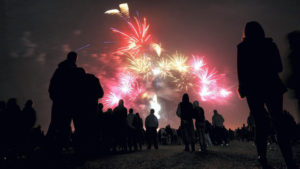 Some holidays are cross cultural. All Hallows Eve or Halloween, or The Day of the Dead, might not quite coincide on the calendar but everybody gets the gist. The dead, or their spirits, get to rise again, either via joyous celebration, honouring of the ancestors, or in the imagination ( see Spine-chilling Tales ). Christmas, Eid, Hannukah are religious festivals ( with lots of cross over ). Thanksgiving, either US or Canadian, is readily understandable and has echoes of other ‘thanks after an ordeal’ type holidays. There are the markers of the year – Midsummer, New Year – but Bonfire Night…?
Some holidays are cross cultural. All Hallows Eve or Halloween, or The Day of the Dead, might not quite coincide on the calendar but everybody gets the gist. The dead, or their spirits, get to rise again, either via joyous celebration, honouring of the ancestors, or in the imagination ( see Spine-chilling Tales ). Christmas, Eid, Hannukah are religious festivals ( with lots of cross over ). Thanksgiving, either US or Canadian, is readily understandable and has echoes of other ‘thanks after an ordeal’ type holidays. There are the markers of the year – Midsummer, New Year – but Bonfire Night…?
Well, in the first place it’s very specific, relating to events in November 1605 in England. In the second, the  political context is quite complex – it’s an assassination attempt by Catholics on a Protestant monarch who has Catholic and Protestant subjects, advisers and relatives and a Parliament ( or at least an upper House ) containing men of both religions. Yes, Catholics are ‘persecuted’, but not in the way they were under previous monarchs, nor in the way Protestants were in, say, the Spain of Fernando and Isabel (by the Inquisition). Also, the form the celebration takes is not straightforward to explain, as I found when trying to do so to a Spanish friend.
political context is quite complex – it’s an assassination attempt by Catholics on a Protestant monarch who has Catholic and Protestant subjects, advisers and relatives and a Parliament ( or at least an upper House ) containing men of both religions. Yes, Catholics are ‘persecuted’, but not in the way they were under previous monarchs, nor in the way Protestants were in, say, the Spain of Fernando and Isabel (by the Inquisition). Also, the form the celebration takes is not straightforward to explain, as I found when trying to do so to a Spanish friend.
‘So, what is this Bonfire Night in November? Fires and fireworks.’
I explain about the Gunpowder Plot and Guy Fawkes.
‘Ah, the fireworks are the explosives which didn’t go off. Then Fawkes is burned at the stake.’
‘Er, no, the bonfires are celebratory of the failure of the plot.’
‘So what happened to him?’
‘He was executed in the usual – horrible – way.’
‘But why is he on the bonfire then?’
‘Oh, that’s just a sort of general burning an enemy in effigy. When I was young there would be competition among children to produce the ‘best’ Guy and they would tour the streets with their version asking for ‘A penny for the Guy’.’
‘Begging was encouraged at this time of year.’
‘No. Sort of…. it was in small communities, every one knew every one.’
‘A reward then?’
‘Yes, that’s closer in spirit. Then the community comes together to celebrate around the bonfire, watch the fireworks and eat and drink.’
 That bit my friend understood well.
That bit my friend understood well.
I learned, however, that Spain, and other countries, also have a Bonfire Night, but this is on St John’s Eve, the 23rd June, the feast of Saint John the Baptist, and it doubles with the celebration of midsummer. The bonfires are lit to keep the evil spirits and witches away. I also learned that Gogol had written a short story entitled St John’s Eve, involving an abandoned village, the devil and some treasure, which inspired Mussorgsky’s Night on a Bald Mountain, originally entitled St John’s Night on the Bare Mountain. It was an enlightening cross-cultural conversation, as such conversations often are.
Enjoy this evening and wave a sparkler for me, still indoors.
If you enjoy reading about traditional holidays and custom why not try December – Advent September Our Lady of Mercy Vendimia Zambomba! Carnaval Sunday Semana Santa in Jerez


 RSS – Posts
RSS – Posts